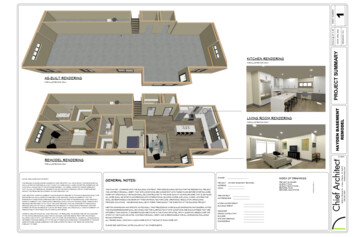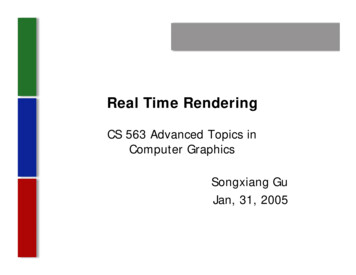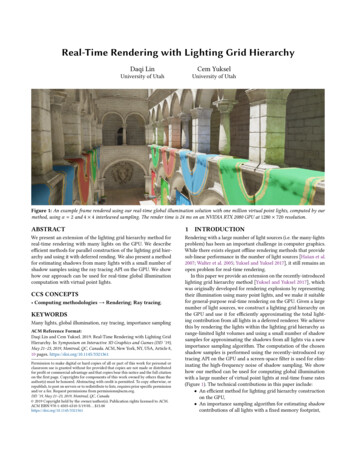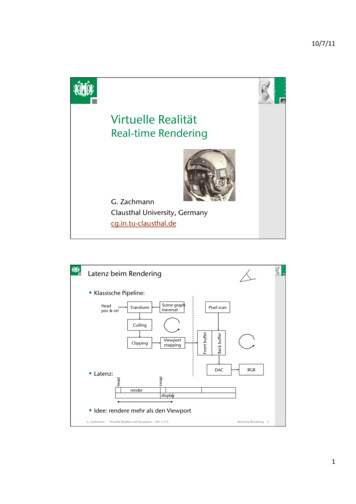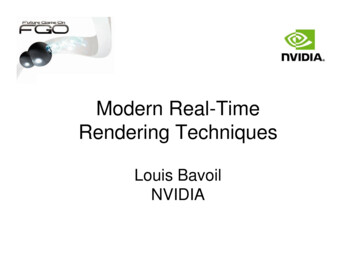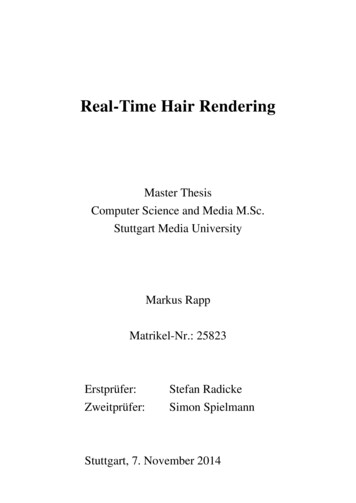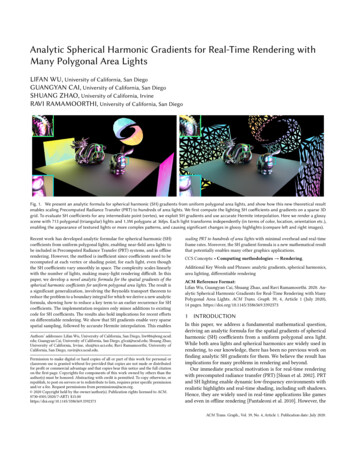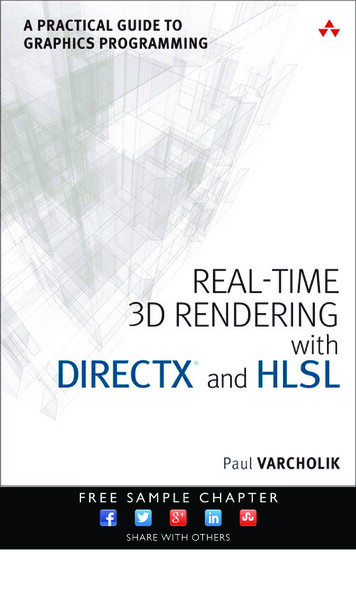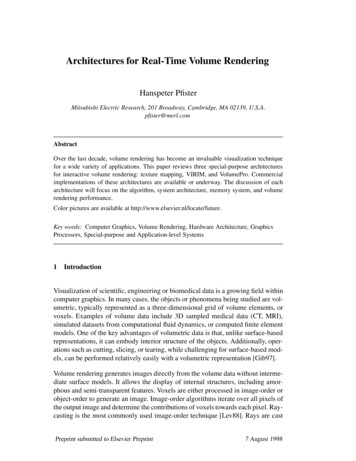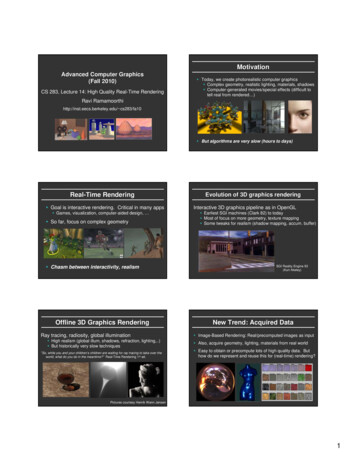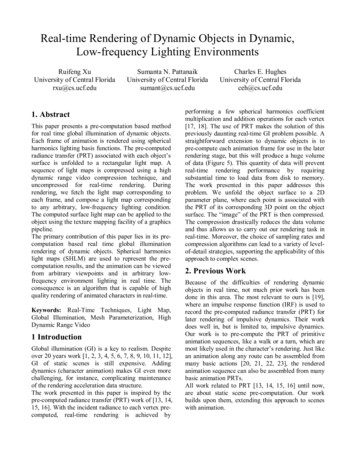
Transcription
Real-time Rendering of Dynamic Objects in Dynamic,Low-frequency Lighting EnvironmentsRuifeng XuUniversity of Central Floridarxu@cs.ucf.eduSumanta N. PattanaikUniversity of Central Floridasumant@cs.ucf.edu1. AbstractThis paper presents a pre-computation based methodfor real time global illumination of dynamic objects.Each frame of animation is rendered using sphericalharmonics lighting basis functions. The pre-computedradiance transfer (PRT) associated with each object’ssurface is unfolded to a rectangular light map. Asequence of light maps is compressed using a highdynamic range video compression technique, anduncompressed for real-time rendering. Duringrendering, we fetch the light map corresponding toeach frame, and compose a light map correspondingto any arbitrary, low-frequency lighting condition.The computed surface light map can be applied to theobject using the texture mapping facility of a graphicspipeline.The primary contribution of this paper lies in its precomputation based real time global illuminationrendering of dynamic objects. Spherical harmonicslight maps (SHLM) are used to represent the precomputation results, and the animation can be viewedfrom arbitrary viewpoints and in arbitrary lowfrequency environment lighting in real time. Theconsequence is an algorithm that is capable of highquality rendering of animated characters in real-time.Keywords: Real-Time Techniques, Light Map,Global Illumination, Mesh Parameterization, HighDynamic Range Video1 IntroductionGlobal illumination (GI) is a key to realism. Despiteover 20 years work [1, 2, 3, 4, 5, 6, 7, 8, 9, 10, 11, 12],GI of static scenes is still expensive. Addingdynamics (character animation) makes GI even morechallenging, for instance, complicating maintenanceof the rendering acceleration data structure.The work presented in this paper is inspired by thepre-computed radiance transfer (PRT) work of [13, 14,15, 16]. With the incident radiance to each vertex precomputed, real-time rendering is achieved byCharles E. HughesUniversity of Central Floridaceh@cs.ucf.eduperforming a few spherical harmonics coefficientmultiplication and addition operations for each vertex[17, 18]. The use of PRT makes the solution of thispreviously daunting real-time GI problem possible. Astraightforward extension to dynamic objects is topre-compute each animation frame for use in the laterrendering stage, but this will produce a huge volumeof data (Figure 5). This quantity of data will preventreal-time rendering performance by requiringsubstantial time to load data from disk to memory.The work presented in this paper addresses thisproblem. We unfold the object surface to a 2Dparameter plane, where each point is associated withthe PRT of its corresponding 3D point on the objectsurface. The “image” of the PRT is then compressed.The compression drastically reduces the data volumeand thus allows us to carry out our rendering task inreal-time. Moreover, the choice of sampling rates andcompression algorithms can lead to a variety of levelof-detail strategies, supporting the applicability of thisapproach to complex scenes.2. Previous WorkBecause of the difficulties of rendering dynamicobjects in real time, not much prior work has beendone in this area. The most relevant to ours is [19],where an impulse response function (IRF) is used torecord the pre-computed radiance transfer (PRT) forlater rendering of impulsive dynamics. Their workdoes well in, but is limited to, impulsive dynamics.Our work is to pre-compute the PRT of primitiveanimation sequences, like a walk or a turn, which aremost likely used in the character’s rendering. Just likean animation along any route can be assembled frommany basic actions [20, 21, 22, 23], the renderedanimation sequence can also be assembled from manybasic animation PRTs.All work related to PRT [13, 14, 15, 16] until now,are about static scene pre-computation. Our workbuilds upon them, extending this approach to sceneswith animation.
2.1. Organization of the PaperThe rest of the paper first discusses the precomputation process and the real-time renderingprocess. We then present experimental results. Ourfinal sections present our conclusion and indicatefuture directions that this work might take.Pre-computation phase:Step A)For each animation frame kFor each SH basis lighting nFor each triangle abcFind a’b’c’ in parametric spaceFor each pixel d’ inside a’b’c’Find d in object space kStore PRT of d in SHLM n (d’)Step B)kCompress SHLM(a) (see Figure 3)Rendering phase:incident radiance spherical harmonics coefficientvector. Thus, the inherent spatial and temporalcoherence can be retained and exploited usingimage/video compression algorithms applied to PRTdata compression.One key component of our approach is theparameterization of the object surface, i.e., build aone-to-one correspondence between the object surfaceand 2D parameter space, say [0.1] [0.1]. Forgenerality and simplicity, we assume that the objectsurface is made up of triangle meshes. The objectsurface is unfolded using a mesh parameterizationscheme [24, 25, 26, 27, 28], so that a one-to-onecorrespondence is built up between each objectsurface 3D point and each parameter space 2D point,as shown in Figure 2. The 2D parameter space[0.1] [0.1] is sampled and the PRT of each sampleis pre-computed and recorded there.VStep C)During the rendering of frame k Find lighting LLoad SHLMkCompute SHLM for LFeed SHLM to graphics pipelinep0 (b)Figure 1: Outline of the pre-computation and renderingprocesses. (a) is the pre-computation process; (b) is therendering process.3. GI Pre-computationOur work is built upon the fact that an animation ismade up of a sequence of animation frames. Eachanimation frame constitutes a particular pose of theanimation. The PRT for each animation frame iscomputed. This process generates a huge volume ofPRT data for an animation. Fortunately, the PRT is ina form ready for compression if recorded in theparameter space of the object surface. The generalprocess is outlined in Figure 1(a).We make use of a known locality property in ourwork: neighboring vertices in space and time tend tohave similar PRT data, i.e., spatial and temporalcoherence applies. This coherence also exists inimage/video, and has been successfully exploited forcompression. In a similar manner, the use ofcoherence-based compression techniques can greatlyreduce PRT data.Unlike previous work, our method computes the PRTfor each sample in the 2D parameter space of theobject surface. In this way, the PRT can be recordedas a 2D “super image”-each pixel consists of anu0p1u1Object surfaceParameter spaceUFigure 2: Unfolding object surface to 2D parameterspace. The left object surface is unfolded to the rightparameter space. p0 is correspondent to u0; p1 to u1.The non-vertex correspondence can be obtained byusing barycentric coordinates, as shown in Figure 3.Vdcaba'd'c‘Object surfaceb'Parameter spaceUFigure 3: Mapping of non-vertex points usingbarycentric coordinates. a, b, c are triangle vertices,and a’,b’,c’ are mapped triangle vertices in parameterspace. Barycentric coordinates of d’ are used to recoverits original surface point d.The incident PRT for each pixel in the parameterspace is then calculated by applying the globalillumination algorithm with each harmonics basisfunction as environment lighting [13, 14, 15, 16]. Theresult is an “image” with each pixel associated withits incident PRT spherical harmonics coefficientsvector. We call this “image” the spherical harmonicslight map (SHLM). In the rest of the paper we use
SHLM nk to denote the SHLM for animation frame k1and spherical harmonics basis lighting Yn .The sampling points located on the triangle edge canbe shared by several neighboring triangles. PRTs forsuch sampling points are often computed more thanonce, and the mean of all the results are stored at thatpoint.3.1 Storage Compression of PRTThe amount of raw data from the pre-computation foran animation is huge (see Figure 5) and to makematters worse the data has a high dynamic range.Fortunately, the image structure of the SHLM, and thespatial and temporal coherence in the data stored inthe SHLM lends itself to very high compression. Asequence of SHLMs constitutes a high dynamic rangevideo, and can be compressed by making use of ourHDR video compression approach. Details of ourHDR video codec are given in the next subsection. Itis convenient to tile all SHLM nk for the sameanimation frame together as one SHLMk. If up toN -th order spherical harmonics lighting are used inthe PRT computation, SHLM nk are placed at location( n/N , n N · n/N ), as shown in Figure 4. Thisresults in a total of N N tiles.kSHLM k SHLM10kFigure 4: Arrangement of SHLM n . The SHLM at rowkr, column c, will be the SHLM 5 r c .The final SHLMk is sent to the HDR video coder forcompression. In our test case, each map is 128 128.The order of the SH used is 2 and this makes a total of3 3 tiles. Thus the resolution of each SHLM k is384 384. Two SHLMs are used to cover the wholebody, so the total SHLM size for one animation frameis 384 768. The original data 384 768 4 100 118M is compressed to 3.5M in 3.6 min on a Xeon2.4GHz PC with 1G memory. The decompressioncost is 78ms for each frame on the same machine.1Yn is actually spherical harmonics basis function Yl mwhere l n and m n l 2 l .3.2 HDR Video CompressionWe use the compression scheme shown in Figure 5.We store the floating point values of the sphericalharmonic coefficients for the 3 color channels usingthe base and exponent used in the RGBE encodingschema [29]. This encoding converts the RGB tripletin floating point to a RGBE quadruplet with 8 bits percomponent. After this encoding, we separate the RGBcomponents to compress them using an existingnormal video compression approach, like MPEG [30].We compress the E component in lossless mode [31].The decision to use a lossless scheme for the Ecomponent is because of the fact that the quality ofthe decompressed HDR data is very sensitive to theerrors introduced in the E component whencompressed using a lossy compression scheme.HDR VideoPixel ELossless VideocompressionFigure 5: General HDR video compression scheme.R,G,B, i.e., color base, and E, i.e., exponential, areseparated and sent to different compression schemes.The HDR video compression mode used in this paper,which is implied by Figure 5 is: HDR video lossy compressionR,G,B channels: lossy (MPEG-4, H.264, etc.)E channel: lossless (FFV1)We control the quality of lossy compression for theRGB components appropriate to our memory budget.An alternative approach we are investigating usesJPEG 2000 [32].JPEG 2000 is a wavelet-based image coding systemfor various types of still images (like grayscale,multicomponent, etc.). Each of its componentssupports dynamic range up to 16 bits. It provides anatural way to encode HDR image in lossy/losslessmode through linear quantization. The contrastsensitivity function (CSF) of the human visual systemused in JPEG 2000 is easy to apply to HDR imageencoding. The encoding/decoding of HDR imagesusing the JPEG 2000 technique [33] is observed about2 times slower than that using JPEG technique [34],which uses discrete cosine transform (DCT), althoughthe former has much better compression quality invery high compression. We are exploring thepossibility of developing an efficient GPUimplementation of the wavelet decoding scheme forthe application of JPEG 2000 technique to HDR video.
4. Rendering of Dynamic ObjectsFor rendering the k-th animation frame during theanimation, we first compute the SH coefficientsLi, i 0,1 , corresponding to the environmentallight at the place [13] where our dynamic object isplaced.LSHLMkSHLM VideoFigure 6: Rendering of a moving character. Currentpose is used as index to fetch SHLMk. Current positionof character is used to estimate the environmentlighting.The SHLMk is retrieved from the compressed HDRvideo. (See section 3.2 for HDR video codec details).The current lighting map is constructed by simplysumming up the product of lighting coefficients andSHLMk, as shown below.(a)(b)SHLM i SHLM ik LiThe obtained SHLM can be sent to the graphicspipeline as a texture. The dynamic object is thenrendered by texture mapping. See Figure 1(b) for theoutline of the program. Figure 6 gives the scenario ofrendering.5. Experimental ResultsOur experimental subject is a future soldier, anOffensive Force Warrior (OFW), modeled using 3DSMAX5.0. For a walk action lasting 2 seconds, weextract 100 frames by sampling its pose every 0.02seconds. Each animation frame consists of 2811vertices and 2197 triangles. A single frame is shownin Figure 7, displayed with lighting (7a) and lightingand texture (7b). The associated SHLM is shown in(7c).We use “Radiance” (see http://radsite.lbl.gov/) to precompute the PRT. The spherical harmonics basislighting is defined as a “glow” type in the “Radiance”scene definition file. For the parameterization, wemake use of the uv coordinates generated by 3DSMAX.The compressed HDR video size varies with thecompression quality. Using the highest compressionquality, compressed data is about 4.2M. Using middlequality, the size dropped to about 3.5M.(c) SHLM31Figure 7: Some results. (a) with only lighting; (b) withlighting and texture;(c) SHLM for animation frame 31with SH order up to 4.The object surface is diffuse with a reflectance of 0.5.Since illumination is executed as a texture mappingprocess, our algorithm is ready for implementation ona GPU. SHLM is assembled in the CPU and sent tothe GPU for rendering.Some statistical data are recorded in Figure 8.There are some ways to improve the performance ofrendering. First, we can run the decompression step ina separate process from the main rendering, andprefetch the SHLM for the next animation frame.Second, it is possible to feed each compressed SHLMto graphics hardware and decompress it using thetexture codec capability of graphics hardware toreduce the traffic between the graphics hardware and
the CPU. Third, we can trade some trivial renderingquality by selecting fewer SH basis lighting functions.As shown in Figure 7(c), most PRT informationconverges to the first 9 SH basis lighting functions.We can also send key frame SHLMs to graphicshardware, and compute all the in-between frames bydoing interpolation in graphics hardware.ObjectOFW(2811vertices;2197triangles)2 sec. of walk (100 frames)2 (9 coefficients)128 by 1281.5 hours for 100 framesActionMax. order of SHSampling RatePre-computation time ofGI computationRaw video data 100 MB (RGBE format)Compressed HDR video 3.5MsizeRendering speed 10 frames/secFigure 8: Some statistics data of our experiment. Theexperiment is performed on an Xeon 2.4G with 1Gmemory running Windows XP.6. ConclusionsWe present a pre-computation based approach forreal-time rendering of dynamic objects. The PRT ofobject surface points are computed and recorded in2D parameterized space to form a sequence ofSHLMs. To save storage this SHLM sequence iscompressed using an HDR video compressiontechnique. Dynamic objects are rendered by addingup the products of SHLMs and their lightingcoefficients, and then applying the result to the objectsurface as a texture.Our approach can perform GI of dynamic objects inreal-time, and the objects can be viewed fromarbitrary viewpoints and illuminated by arbitrarilylow-frequency environment lighting. It is a new wayfor rendering dynamic objects, but it is restricted tothe rendering of predefined actions. Fortunately, thislimit can be overcome by combining this approachwith motion synthesis techniques, like motion graphs[20].Compared to [19], our work is suitable for fixed longactions. It is possible to combine our approach withthat of James and Fatahalian [19] to take advantage ofthe fine dynamics rendering of their approach and ofthe capability for long actions of our approach.Recording each PRT as a 2D rectangular imageprovides several other benefits. Since we record thePRT in 2D parametric space, the size of a PRT isindependent of the number of vertices, but depends ononly the object surface area and sampling rate. Thus,level-of-detail management is possible. Since ourapproach keeps the neighborhood of surface 3Dpoints, the coherence between these neighboringpoints is exploited for data compression. Greatercompression rates are achieved by using lossycompression schemes that throw away some highfrequency information invisible to the human eye.Lossy compression of HDR image/video is a feasibleway to achieve high compression ratio. Finally, thisrepresentation of PRT is easily implemented oncurrent graphics hardware as a simple texturemapping.Our work supports GI features, like self-shadowingand self-reflection to make objects look more realistic,but it cannot create neighboring shadows.7. Future WorkThe pre-computed data can be first compressed byapplying PCA/CPCA [15, 16]. PCA/CPCA isindependent of our approach and can be used toreduce the number of dimensions before HDR videocompression.We can use any mesh parameterization scheme. Forexample, [25] gives a signal ameterization approach that uses more sampleswherever there are more details.Our approach to store PRT has possible applicationsto other problems. The data from the surface lightfield [35] is of huge volume, and can be reduced bymapping light field data to the parametric space of itssurface for compression. It is also possible to enhancethe rendering effects by using BTF [14].Another way of improving performance is to precompute only key animation frames, and interpolatefor in-between frames in later rendering. We can alsouse non-uniform sampling; where the motion issmooth, we use a lower frame rate; where the motionis abrupt, we use a higher frame rateIn some cases where animation blending or inversekinematics is applied, SHLMs can be blended ormodified accordingly.AcknowledgementsThis work is partially supported by Office of NavalResearch, ATI Research and the I-4 Corridor Fund.References[1] J. F. Blinn and M. E. Newell. Texture andReflection in Computer Generated Images. InCommunications of the ACM, 19, 542-546, 1976
[2] R. L. Cook, L. Carpenter, and E. Catmull. TheReyes image Rendering Architecture. InComputer Graphics (ACM SIGGRAPH 87Proceedings)(July 1987), M. C. Stone, Ed., 21,273-281, 1987[3] P. Debevec. Rendering Synthetic Objects intoReal Scenes: Bridging Traditional And Imagebased Graphics with Global Illumination andHigh Dynamic Range Photography. InProceedings of ACM SIGGRAPH 98 (July 1998),M. Cohen, Ed., 189-198, 1998[4] H. W. Jensen and P. H. Christensen. EfficientSimulation of Light Transport in Scenes withParticipating Media using Photo Maps. In ACMSIGGRAPH 98 Proceedings, 311-320, 1998[5] J. T. KaJiya. The Rendering Equation. InComputer Graphics (ACM SIGGRAPH 86Proceedings)(Aug. 1986), D. C. Evans and R. J.Athay, Eds., 20, 143-150, 1986[6] E. Veach and L. J. Guibas. Metropolis LightTransport. In ACM SIGGRAPH 97 Proceedings(Aug. 1997), T. Whitted, Ed., 65-76, 1997[7] G. J. Ward. The RADIANCE Lighting Simulationand Rendering System. In Proceedings of ACMSIGGRAPH 94, A. Glaussner, Ed.,459-472, 1994[8] M. Levoy and P. Hanrahan. Light FieldRendering. In ACM SIGGRAPH 96 Proceedings,H.Rushmeier, Ed., 31-42, 1996[9] D. A. Forsyth, C. K. Yang, and K. B. Teo.Efficient Radiosity in Dynamic Dnvironments. InProc 5'th Eurographics Workshop on Rendering,313-323, 1994[10]P. Tole, F. Pellacini, B. Walter, and D. P.Greenberg. Interactive Global Illumination inDynamic Scenes. In ACM Transactions onGraphics(Proceedings of ACM SIGGRAPH2002), 21, 3, 537-546, 2002[11]K. Bala, B. J. Walter and D. P. Greenberg.Combining Edges and Points for InteractiveHigh-Quality Rendering. In ACM Transactionson Graphics (Proceedings of ACM SIGGRAPH2003), 22, 3, 631-640, 2003[12]I. Wald, T. Kollig, C. Benthin, A. Keller, andP. Slusallek. Interactive Global Illumination usingFast Ray Tracing. In Rendering Techniques2002(Proceedings of the 13th EurographicsWorkshop on Rendering), 15-24, 2002[13]P. -P. Sloan, J. Kautz, and J. Snyder.Precomputed Radiance Transfer for Real-timeRendering in Dynamic, Low-frequency LightingEnvironments. In ACM Transactions on Graphics,21, 3, 527-536, 2002[14]P. -P. Sloan, X. Liu, H. -Y. Shum, and J.Synder. Bi-Scale Radiance Transfer. In ACMTransactions on Graphics(Proceedings of ACMSIGGRAPH 2003), 22, 3, 370-375, 2003[15]P. -P. Sloan, J. Hall, J. Hart, and J. Snyder.Clustered Principal Components for PrecomputedRadiance Transfer. In ACM Transactions onGraphics(Proceedings of ACM SIGGRAPH2003), 22, 3, 382-391, 2003[16]J. Lehtinen and J. Kautz. Matrix RadianceTransfer. In Proceedings of ACM SIGGRAPH2003 Symposium on Interactive 3D Graphics, 5964, 2003[17]R. Ramamoorthi and P. Hanrahan. AnEfficientRepresentationforIrradianceEnvironment Maps. In Proceedings of ACMSIGGRAPH 2001, 497-500, 2001[18]R. Ramamoorthi and P. Hanrahan. SignalProcessing Framework for Inverse Rendering. InProceedings of ACM SIGGRAPH 2001, 117-128,2001[19]D. L. James and K. Fatahalian. PrecomputingInteractive Dynamic Deformable Scenes. In ACMTransactions on Graphics (Proceedings of ACMSIGGRAPH 2003), 22, 3, 879-887, 2003[20]L. Kovar, M. Gleicher and F. Pighin. MotionGraphs. In Proceeding of ACM SIGGRAPH 2002,473-482, 2002[21]C. –K. Liu, and Z. Popovic. Synthesis ofComplex Dynamic Character Motion fromSimple Animations. In Proceedings of ACMSIGGRAPH 2002, 408-416, 2002[22]Y. Li, T. Wang, and H. –Y. Shum. MotionTexture: A Two-Level Statistical Model forCharacter Motion Synthesis. In Proceedings ofACM SIGGRAPH 2002, 465-472, 2002[23]O. Arikan and D. A. Forsyth. InteractiveMotion Generation from Examples. InProceedings of ACM SIGGRAPH 2002, 483-490,2002[24]X. Gu, S. J. Gortler, and H. Hoppe. GeometryImages. In Proceedings of ACM SIGGRAPH2002, 355-361, 2002[25]P. V. Sander, S. J. Gortler, J. Snyder, and H.Hoppe. Signal-Specialized Parameterization. InThirteenth Eurographics Workshop on Rendering(2002), 87-98, 2002[26]P. Alliez, M. Meyer, and M. Desbrun.Interactive Geometry Remeshing. In Proceedingsof ACM SIGGRAPH 2002, 347-354, 2002[27]B. Levy, S. Petitjean, N. Ray, and J. Maillot.Least Square Conformal Maps for Automatic
Texture Atlas Generation. In Proceedings ofACM SIGGRAPH 2002, 362-371, 2002[28]A. Khodakovsky, N. Litke and P. Schroder.Globally Smooth Parameterizations with LowDistortion. In Proceedings of ACM SIGGRAPH2003, 350-357, 2003[29]G. W. Larson. Real pixels. Graphics Gems II.Academic Press. pp. 80-83, 1991[30]D. Salomen. Data Compression: Thecomplete Reference (2nd edtion), Springer, 2000[31]FFV1.http://www.mplayerhq.hu/ michael/ffv1.html.2004[32]D. S. Taubman and M. W. Marcellin. JPEG2000: Image Compression Fundamentals,Standards, and Practice. Kluwer AcademicPublishers, Boston, 2002[33]JasPer.http://www.ece.uvic.ca/ mdadams/jasper/index.html. .org2.html.2004[35]W. –C. Chen, J. –Y. Bouguet, M. Chu, and R.Grzeszczuk. Light Field Mapping: EfficientRepresentation and Hardware Rendering ofSurface Light Field. In Proceedings of ACMSIGGRAPH 2002, 447-456, 2002
frequency environment lighting in real time. The consequence is an algorithm that is capable of high quality rendering of animated characters in real-time. Keywords: Real-Time Techniques, Light Map, Global Illumination, Mesh Parameterization, High Dynamic Range Video 1 Introduction Global illumination (GI) is a key to realism. Despite

